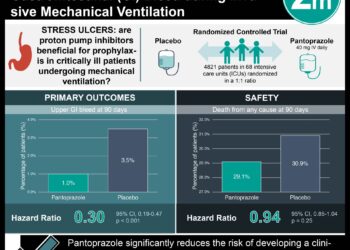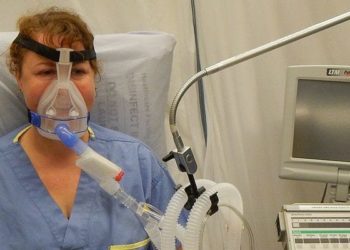Intraoperative PEEP levels may not affect post-operative pulmonary complications
1. No difference was found in the incidence of post-operative pulmonary complications between patients set to a higher level of positive end expiratory pressure( PEEP) (12 cm H2O) versus those at a lower positive end-expiratory pressure (≤2 cm H2O) during intraoperative mechanical ventilation.
2. Intra-operatively, the high PEEP group had a higher incidence of hypotension and the requirement for vasoactive drugs.
Evidence Rating Level: 1 (Excellent)
Study Rundown: Post-operative pulmonary complications are associated with increased risk of in hospital mortality, notably with open abdominal surgery. The current theory implicates hyperinflation and repeated tidal recruitment of lung units due to mechanical ventilation as contributing factors for such complications. Present research efforts have attempted to explore and configure optimal ventilatory settings for patients in order to minimize these occurrences. Two recent studies have found lowered rates of pulmonary complications with the use of low tidal volumes and high levels of positive end-expiratory pressure (PEEP); however, the study design prevented identification of which ventilation characteristic was chiefly responsible for the observed reduction in complication rate. Through a randomized prospective study, the authors found no difference in the rate of post-operative pulmonary complications between the use of high PEEP or low PEEP with identically low tidal volumes in both groups. These findings suggest no protective benefit from the use of high PEEP with general anesthesia for the prevention of pulmonary complications in abdominal surgery. The incidence of intraoperative hypotension was also noted to be elevated in the high PEEP group, supporting the use of low PEEP particularly in high-risk cardiac patients. Limitations of the study include the lack of standardization in the post-operative care as the final administration of fluids and medications was largely at the discretion of the individual medical team.
Click to read the study in Lancet
Click to read an accompanying editorial in Lancet
Relevant Reading: A trial of intraoperative low-tidal-volume ventilation in abdominal surgery
In-Depth [randomized controlled trial]: A total of 894 patients undergoing abdominal surgery were enrolled from 30 medical centers across Europe and North and South America. Exclusion criteria included those undergoing laparoscopic surgery and the morbidly obese. 445 individuals were randomized to the higher PEEP group (12 cm H2O) and 449 to the lower PEEP group (≤2 cm H2O). Tidal volumes were set to 8 mL/kg predicted body weight in both groups. Following surgery, patients were assessed daily and any complications were noted until post-operative day 5. Total pulmonary complications were noted in 40% of individuals in the higher PEEP group, compared to 39% of the lower PEEP group (p=.84). No significant differences were found in rates of any specific pulmonary complications between both groups. Individuals in the higher PEEP were additionally at a 29% increased risk for hemodynamic compromise than those in the lower PEEP group (RR 1.20, 95%CI 1.10-1.51, p =.0016).
More from this author: Lower rates of repeat intervention following ureteroscopy for kidney stones, Tumor size, chemoembolization response may predict hepatocellular carcinoma recurrence, Increased incidence of stroke found after aortic valve replacement
Image: PD
©2012-2014 2minutemedicine.com. All rights reserved. No works may be reproduced without expressed written consent from 2minutemedicine.com. Disclaimer: We present factual information directly from peer reviewed medical journals. No post should be construed as medical advice and is not intended as such by the authors, editors, staff or by 2minutemedicine.com. PLEASE SEE A HEALTHCARE PROVIDER IN YOUR AREA IF YOU SEEK MEDICAL ADVICE OF ANY SORT.






